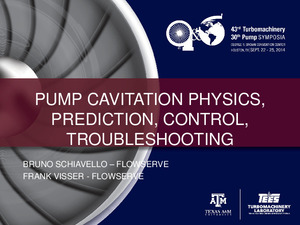Pump Cavitation Physics, Prediction, Control, Troubleshooting
Abstract
This short course deals with cavitation in general and rotodynamic pump cavitation in particular. It gives an introduction to the subject matter and provides insights in particulars like cavitation inception, 3% head drop, and 40,000 hours impeller life, as well as NPSH scaling laws. It further devotes attention to the effect of dissolved gases, and thermal suppression (i.e. thermodynamic effect) when pumping hot water or hydrocarbons. For (hydrocarbon) mixtures it will also be outlined that cavitation intensity can be expected to be far less than with pure fluids. With regard to numerical prediction capabilities the use of Computational Fluid Dynamics (CFD) shall be discussed, and empirical correlations will be presented. Furthermore, some guidance for cavitation damage diagnosis shall be given, including prediction of cavitation erosion rate, and assessment of impeller life expectancy. Also addressed are suction specific speed, and how this dimensionless group tends to cause bias and give rise to misunderstanding and misinterpretation. In this context also the corrected suction specific speed will be presented, and the concept of suction energy will be discussed. Furthermore, NPSHR criteria and establishing NPSHA margins will be outlined. As special modes of operation, the effect of fluid transients will be highlighted, demonstrating that such may yield excessive cavitation. Furthermore, a qualitative “Cavitation Modes Map” will be presented, which reflects five decades of fundamental cavitation observations and experimental facts (laboratory research and field data) published in the years 1941 – 1991. In particular, the typical shape of the erosion curve versus flow – seemingly peculiar, but fully supported by cavitation physics for all types of rotodynamic pumps – is discussed by highlighting an absolutely striking departure from the shape of conventional NPSHR3% curve (universally used for decades) at part flows. This deviation, which has been fully ignored in the past and is today still often neglected at various stages (pump specifications and selection, pump design, and field root cause analysis) is a primary reason of the majority of cavitation pump problems, as will be explained in this short course. The course further includes four Field Case Studies demonstrating the practical application of “Cavitation Failure Analysis – Methodology (Diagnosis and Solution Strategy)“, covering low and high energy, single- and multistage, pumps.
Description
Short CourseSubject
Pumping machineryCollections
Citation
Schiavello, Bruno; Visser, Frank C. (2014). Pump Cavitation Physics, Prediction, Control, Troubleshooting. Texas A&M University. Turbomachinery Laboratories. Available electronically from https : / /hdl .handle .net /1969 .1 /162832.


